The PLL Clock Generator Market is estimated to be valued at USD 7.5 billion in 2025 and is projected to reach USD 13.3 billion by 2035, registering a compound annual growth rate (CAGR) of 5.9% over the forecast period.
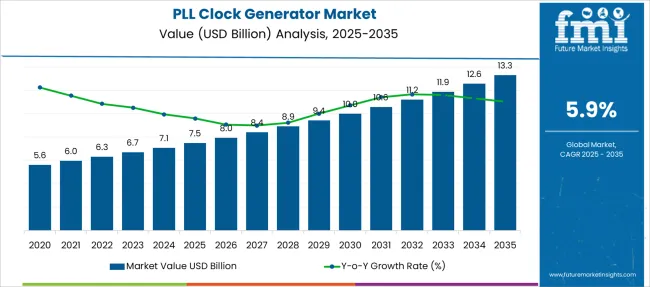
| Metric | Value |
|---|---|
| PLL Clock Generator Market Estimated Value in (2025 E) | USD 7.5 billion |
| PLL Clock Generator Market Forecast Value in (2035 F) | USD 13.3 billion |
| Forecast CAGR (2025 to 2035) | 5.9% |
The PLL clock generator market is undergoing strong technological advancement, fueled by increasing demand for precise timing solutions in data centers, 5G infrastructure, and consumer electronics. As semiconductor devices grow in complexity and require faster data transfer with reduced jitter and phase noise, phase-locked loop (PLL) architectures are gaining strategic relevance.
Enhanced performance in synchronous communication, efficient frequency synthesis, and reduced signal distortion have made these clock generators essential in high-speed SoCs and multi-core processor applications. Advancements in node miniaturization, integration of PLL IP into ASIC and FPGA designs, and the rise of AI workloads have created long-term growth opportunities.
Additionally, the shift toward low-power architectures and integration of mixed-signal ICs in edge devices are expected to expand market deployment across automotive, IoT, and industrial applications. Strategic collaborations between IC manufacturers and system designers are also accelerating product development cycles and reducing time-to-market for next-generation clocking solutions.
The market is segmented by Output Frequency and Output Stage and region. By Output Frequency, the market is divided into 200 to 400 MHz PLL Clock Generator, Less than 200 MHz PLL Clock Generator, 400 to 600 MHz PLL Clock Generator, and 600 to 800 MHz PLL Clock Generator. In terms of Output Stage, the market is classified into CMOS, CMOS, PECL, Clock, PECL, and LVCMOS. Regionally, the market is classified into North America, Latin America, Western Europe, Eastern Europe, Balkan & Baltic Countries, Russia & Belarus, Central Asia, East Asia, South Asia & Pacific, and the Middle East & Africa.
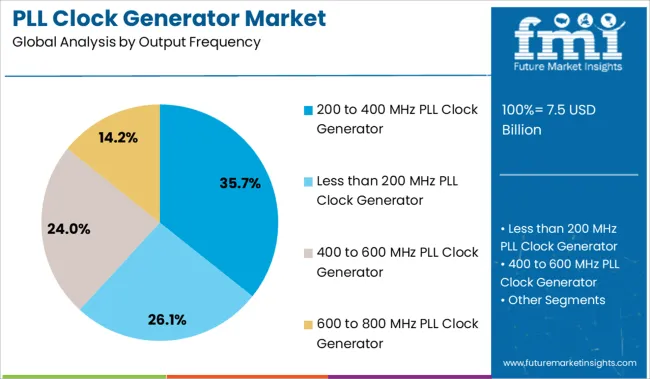
The 200 to 400 MHz PLL clock generator segment is projected to hold 35.7% of the total market revenue by 2025, positioning it as the leading output frequency range. Its leadership has been supported by its versatility in serving mid-range timing requirements across a wide range of consumer electronics, industrial control systems, and telecommunications equipment.
The frequency range is widely adopted in high-speed data buses and interface protocols, providing an optimal balance between performance and power efficiency. Moreover, the 200 to 400 MHz range aligns well with current requirements in memory interfaces and peripheral clocking in multi-frequency environments.
Widespread compatibility with both analog and digital circuitry has further extended its utility, especially as SoC integration accelerates across emerging markets. Cost-efficiency and reduced design complexity have made this range attractive for large-volume manufacturing.
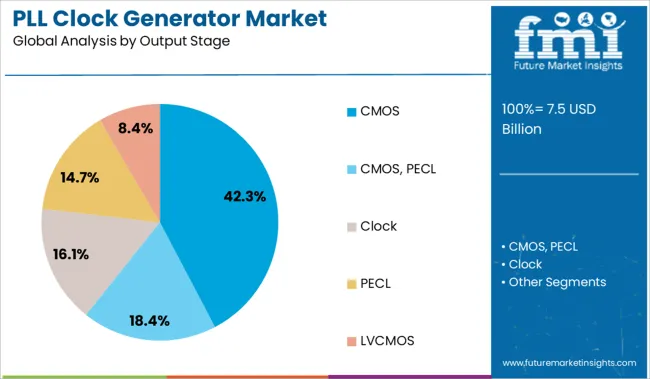
CMOS output stages are anticipated to account for 42.3% of the PLL clock generator market revenue by 2025, making it the dominant segment by output stage. This dominance is underpinned by CMOS technology’s low power consumption, high noise immunity, and scalability in sub-micron fabrication processes.
CMOS-based PLLs are widely preferred in battery-operated and thermally constrained environments, particularly in portable consumer electronics and embedded systems. Their ability to deliver consistent output voltage levels while maintaining low electromagnetic interference has made them integral to high-speed and noise-sensitive applications.
Additionally, the economic advantages of CMOS fabrication and its compatibility with advanced digital logic make it a preferred choice for large-scale deployment. As industry moves toward higher integration and reduced form factors, CMOS output stages continue to offer a favorable trade-off between performance, cost, and power efficiency.
Growing Applications in Many Devices Drive the Growth of the Market
With the increasingly stringent timing constraints required in high-performance systems extensively used in day-to-day applications today, the PLL clock generator is finding its applications in myriads of devices. This extensive use of the PLL clock generator is expected to increase its demand in the market, witnessing a healthy CAGR in the forecast period.
Phase/delay compensation, frequency multiplication, duty cycle correction, decreased noise, and jitter are some of the key benefits, offered by the PLL clock generator, which are not present in simple clock generators. As the PLL clock generator is the basic building block of any system, these benefits basically eliminate all the errors that can occur while frequency generation. This highly reduces the probability of errors in the overall system, may the PLL clock generator is deployed in any system.
High Cost May Impede the Growth of the Market
Although the PLL clock generator market has numerous end-uses, there are numerous obstacles that likely pose a challenge to market growth. Factors such as high cost can be expected to make a negative impact on the market in short term, but as the benefits from the PLL clock generator are ascertained, the overall impact will diminish in the long term.
However, the paradigm shifts from using basic clock generators to PLL clock generators, due to reduced jitter and noise, thereby increasing the overall efficiency of the systems in which the PLL clock generators are deployed, which is expected to continue propelling the market for PLL clock generators during the forecast period
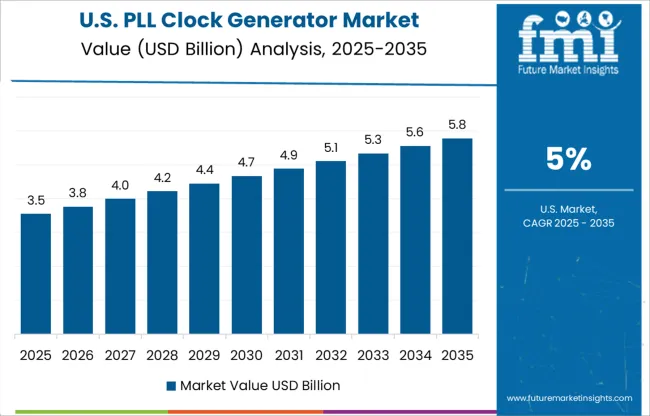
Increase in Adoption of Smart Devices Driving Market Expansion
North America will continue to dominate the global PLL clock generator market attributed to the significant demand for high-quality, durable, and unique features n gadgets. North America accounts for a total of 32.2% of the global PLL clock generator market share.
The increasing use in end-use applications ranging from IoT, connected devices, and artificial intelligence are effectively leveraging the use of the PLL clock generator. Furthermore, defense and commercial applications involving 5G technologies boost market size across the USA
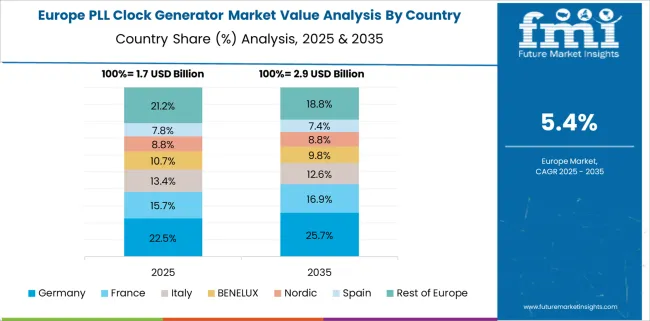
Increasing Advancements in Semiconductor System Designs Driving Market Growth in Europe
According to Future Market Insights, Europe is expected to provide immense growth opportunities for the PLL clock generator market, due to the presence of a large number of semiconductor industries. Europe is projected to account for 21.1% of the total market share in the PLL clock generator market during the assessment period.
The market is interspersed with increasing investments by prominent market players. Advanced semiconductor system design and manufacturing, rising investments by key players in electric vehicles, and growing usage of smartphones are driving market growth in Europe.
The Asia Pacific is anticipated to exhibit a significant growth rate in the PLL clock generator market over the forecast period. The growth of the market in the region is attributed to the growing electronic industry.
Due to the rising use of semiconductor systems in various industries, including automotive, consumer electronics, IT, and telecommunications, the PLL clock generator market is expected to witness growth in the region. Also, the growing use of consumer electronics, automotive applications, and manufacturing applications of the Internet of Things (IoT), as well as rapid IoT adoption in many of these sectors also boosts the market demand.
Asia-Pacific is expected to register the fastest growth in revenue generation in the PLL clock generator market due to the presence of giant local manufacturers in countries, such as Japan, China, and India.
The new entrants in the PLL clock generator market are continually indulging in several collaborations and highly investing in research and development activities to provide more convenient solutions to industry verticals. Some of the major start-ups that are leading the development of the market are - Mouser Electronics and Maxmimintegrated
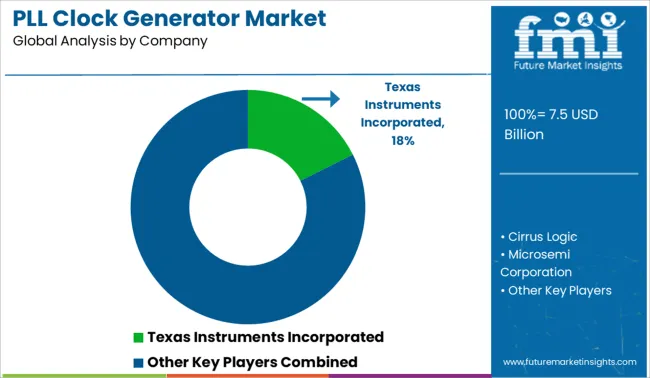
Cirrus Logic, Microsemi Corporation, ON Semiconductor, Maxim Integrated, Integrated Device Technology, Inc., and Texas Instruments Incorporated, are some of the key players in the PLL Clock Generator market.
Key development:
Product launch
| Report Attribute | Details |
|---|---|
| Growth Rate | CAGR of 5.9% from 2025 to 2035 |
| Expected Market Value (2025) | USD 7.5 billion |
| Anticipated Forecast Value (2035) | USD 13.3 billion |
| Base Year for Estimation | 2024 |
| Historical Data | 2020 to 2024 |
| Forecast Period | 2025 to 2035 |
| Quantitative Units | Revenue in USD Million and CAGR from 2025 to 2035 |
| Report Coverage | Revenue Forecast, Volume Forecast, Company Ranking, Competitive Landscape, Growth Factors, Trends, and Pricing Analysis |
| Segments Covered | Output Frequency, Output Stage, Region |
| Regions Covered | North America; Latin America; Europe; Asia Pacific; Middle East and Africa |
| Key Countries Profiled | USA, Canada, Mexico, Brazil, Germany, Italy, France, United Kingdom, Spain, China, Japan, South Korea, Indonesia, Thailand, Singapore, Australia, New Zealand, GCC Countries, South Africa, Israel |
| Key Companies Profiled | Cirrus Logic; Microsemi Corporation; ON Semiconductor; Maxim Integrated; Integrated Device Technology Inc.; Texas Instruments Incorporated |
| Customization | Available Upon Request |
The global PLL clock generator market is estimated to be valued at USD 7.5 billion in 2025.
The market size for the PLL clock generator market is projected to reach USD 13.3 billion by 2035.
The PLL clock generator market is expected to grow at a 5.9% CAGR between 2025 and 2035.
The key product types in PLL clock generator market are 200 to 400 mhz PLL clock generator, less than 200 mhz PLL clock generator, 400 to 600 mhz PLL clock generator and 600 to 800 mhz PLL clock generator.
In terms of output stage, cmos segment to command 42.3% share in the PLL clock generator market in 2025.






Full Research Suite comprises of:
Market outlook & trends analysis
Interviews & case studies
Strategic recommendations
Vendor profiles & capabilities analysis
5-year forecasts
8 regions and 60+ country-level data splits
Market segment data splits
12 months of continuous data updates
DELIVERED AS:
PDF EXCEL ONLINE
Atomic Clock Oscillators Market Forecast and Outlook 2025 to 2035
Atomic Clock Market Size and Share Forecast Outlook 2025 to 2035
Atomic System Clocks Market Forecast and Outlook 2025 to 2035
Optical Lattice Clock Market Size and Share Forecast Outlook 2025 to 2035
Wireless Synchronized Clocks Market Trends - Growth & Forecast 2025 to 2035
Strontium Optical Lattice Clock Market Size and Share Forecast Outlook 2025 to 2035
Generator Sales Market Size and Share Forecast Outlook 2025 to 2035
Generator Sets Market Size and Share Forecast Outlook 2025 to 2035
Gas Generator Sets Market Growth - Trends & Forecast 2025 to 2035
Hydrogenerators Market
Power Generator for Military Market Size and Share Forecast Outlook 2025 to 2035
Motor Generator Set Market Size, Growth, and Forecast 2025 to 2035
Pulse Generator Market
Ozone Generators Market
Hybrid Generator Sets Market Size and Share Forecast Outlook 2025 to 2035
Signal Generator Market Analysis by Product, Technology, Application, End-use, and Region through 2035
Silent Generator Market Analysis by Sound Level, Type, Phase, Power Rating, Fuel, Application, End User, and Region through 2035
Standby Generator Sets Market Size and Share Forecast Outlook 2025 to 2035
Telecom Generator Market Size and Share Forecast Outlook 2025 to 2035
Railway Generators Market Growth - Trends & Forecast 2025 to 2035

Thank you!
You will receive an email from our Business Development Manager. Please be sure to check your SPAM/JUNK folder too.
Chat With
MaRIA